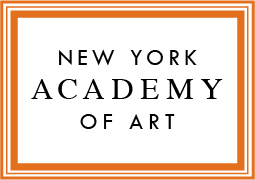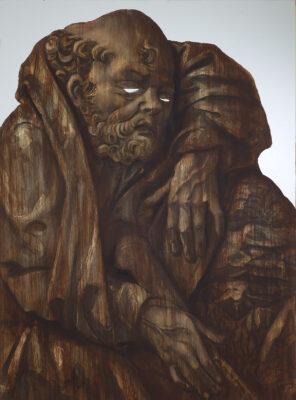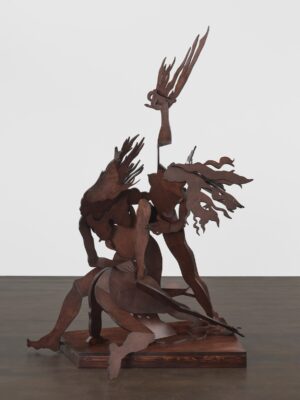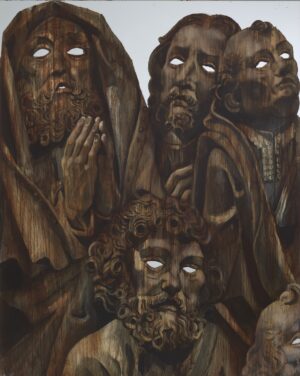I’ve always been interested in portraying some kind of fantasy, then showing that it’s completely constructed. There are always dark messages hidden behind beauty, and the act of sculpting is about listening to that inner voice that warns you about something lurking beneath the surface.
—Rachel Feinstein
In richly detailed sculptures and multipart installations, Rachel Feinstein investigates and challenges the concept of luxury as expressed in eighteenth- and nineteenth-century Europe, in the context of contemporary parallels. By synthesizing visual and societal opposites such as romance and pornography, elegance and kitsch, and the marvelous and the banal, she explores issues of taste and desire.
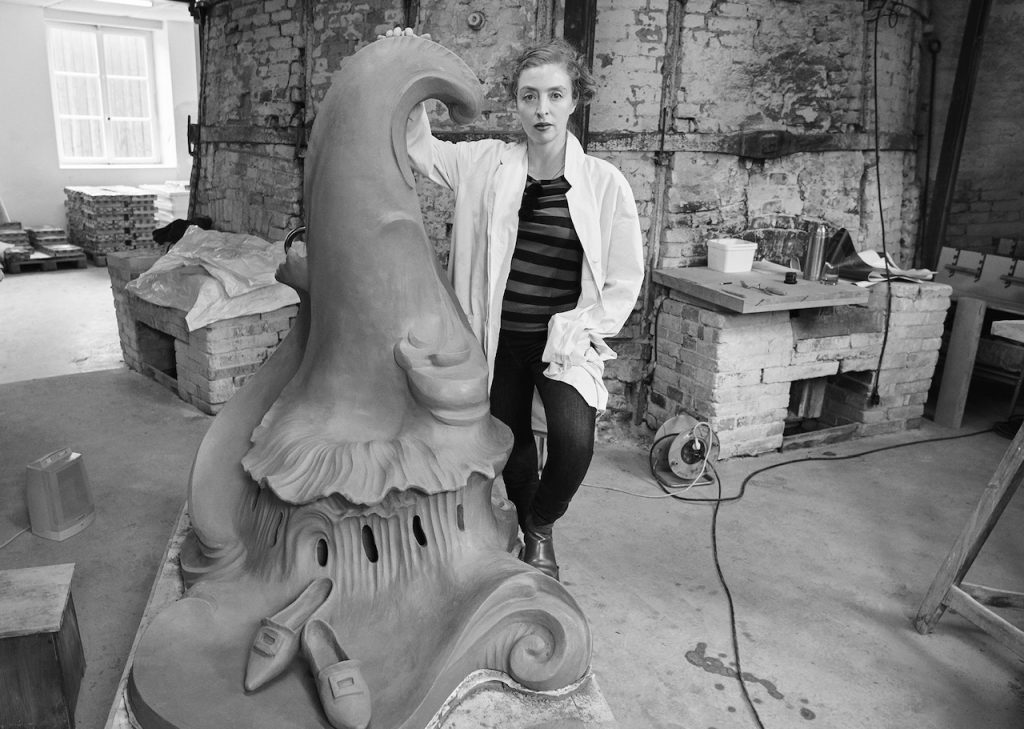
Born in Fort Defiance, Arizona, and raised in Miami, Feinstein received a BA in 1992 from Columbia University, New York, where she studied religion, philosophy, and studio art. That same year she attended the Skowhegan School of Painting and Sculpture in Madison, Maine. She found her passion for sculpture under the influence of mentors such as Kiki Smith, Ursula von Rydingsvard, and Judy Pfaff.1 In 1994 Feinstein was included in several group shows in New York, including Let the Artist Live! at Exit Art, where she presented a large gingerbread house modeled after Sleeping Beauty’s castle in which she slept throughout the exhibition.
Feinstein’s work was included in the first iteration of MoMA PS1’s Greater New York in 2000. She had her first solo exhibition at Marianne Boesky Gallery, New York, the following year, showing large plaster and wood sculptures of lions, swans, angels, and waterfalls, and transforming one of the galleries into an all-white Rococo-style salon, inspired by imperial palaces in Munich and Vienna.2 The construction of fantastical, multidimensional environments is integral to Feinstein’s practice. Preferring to see her work in complex interiors, she often brings Baroque elements into exhibition spaces, complicating the relationship between sculpture and painting, positive and negative space. The sculptures, viewed from certain angles, flatten, while the walls seem to expand through Feinstein’s use of mirrors and wallpaper.
Seeing her ornate sculptures reflected in her paintings on mirror from the early 2000s, Feinstein began to explore spatial landscapes, notably those depicted in panoramas from the 1800s. Using found images, she created hybrid arcadian landscapes printed on mirrored wallpaper. The first of these wallpapers, Panorama of Rome (2012), was installed in the elliptical gallery at Gagosian in Rome, offering visitors an impressionistic view of the city around them. In 2010–11 Feinstein transformed the modernist interior of Lever House, New York, into a snowy wonderland, rife with stylized elements of Rococo and Gothic design. Interpreting Hans Christian Anderson’s Snow Queen, she created a gilded carriage, groups of toy soldiers, arched alcoves containing characters from the story, and sublime architectural ruins painted onto floor-to-ceiling mirrors.3 Three years later her sculpture Folly (2014) was installed in New York’s Madison Square Park, marking Feinstein’s first public art exhibition in the US.
In 2018 Feinstein produced the Secrets series, comprising eight large-scale sculptures that reimagine the Victoria’s Secret “Angels,” as well as ceramic sculptures inspired by Franz Anton Bustelli’s Rococo commedia dell’arte figurines. As in much of her work, the theatrical and the intricate verge on the grotesque, becoming strangely erotic abstractions, and suggesting the body through its absence.
Feinstein’s first career survey, Maiden, Mother, Crone at the Jewish Museum, New York (2019–21), presented three decades of her sculptures, paintings, and videos and was accompanied by a major monograph. Titled after three consequential stages in a woman’s life, the exhibition traced her investigations of masculinity and femininity, balance and precariousness. First exhibited in 2022, the Mirror series are oil paintings on mirror supports that reference sixteenth-century sculptural altarpieces. Interpreting the altarpieces’ carved forms, Feinstein leaves her figures’ eyes unpainted, evoking in the viewer an uncanny sense of becoming one with each painting. In 2023, Feinstein’s exhibition Façade at the SCAD Museum of Art, Savannah, Georgia, features her painted panoramas, large-scale sculptures, and wall reliefs in a multidimensional installation that shifts between reality and illusion.
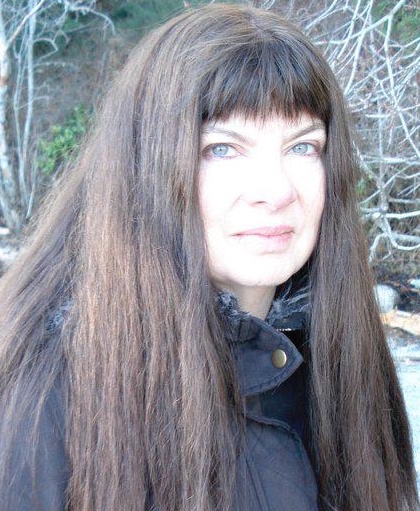 Yvonne Owens is a past Research Fellow at the University College of London, and Professor of Art History and Critical Studies. She was awarded a Marie Curie Ph.D. Fellowship in 2005 for her interdisciplinary dissertation on Renaissance portrayals of women in art and sixteenth-century Witch Hunt discourses. Her publications to date have mainly focused on representations of women and the gendering of evil “defect” in classical humanist discourses, cross-referencing these figures to historical art, natural philosophy, medicine, theology, science and literature. Her landmark essay, “The Saturnine History of Jews and Witches,” appeared in Preternature (Vol. 3, No. 1) in 2014, her book chapter, “Pollution and Desire in Hans Baldung Grien: The Abject, Erotic Spell of the Witch and Dragon” appeared in (Angeliki Pollali and Berthold Hub, Eds.), Images of Sex and Desire in Renaissance Art and Modern Historiography, her essay “The Hags, Harridans, Viragos and Crones of Hans Baldung Grien” was published as part of the Hans Baldung Grien: New perspectives on his work, International Conference Proceedings (October 18-20, 2018), Staatliche Kunsthalle Karlsruhe in 2019, and her book, Abject Eroticism in Northern Renaissance Art: the Witches and Femme Fatales of Hans Baldung Grien, was published by Bloomsbury London in 2020. She also writes art and cultural criticism, exploring contemporary post-humanist discourses in art, literature and new media. She is the editor for an anthology of essays titled ‘Trans-Disciplinary Migrations: Science, the Sacred, and the Arts,’ forthcoming from Cambridge Scholars Publishing.
Yvonne Owens is a past Research Fellow at the University College of London, and Professor of Art History and Critical Studies. She was awarded a Marie Curie Ph.D. Fellowship in 2005 for her interdisciplinary dissertation on Renaissance portrayals of women in art and sixteenth-century Witch Hunt discourses. Her publications to date have mainly focused on representations of women and the gendering of evil “defect” in classical humanist discourses, cross-referencing these figures to historical art, natural philosophy, medicine, theology, science and literature. Her landmark essay, “The Saturnine History of Jews and Witches,” appeared in Preternature (Vol. 3, No. 1) in 2014, her book chapter, “Pollution and Desire in Hans Baldung Grien: The Abject, Erotic Spell of the Witch and Dragon” appeared in (Angeliki Pollali and Berthold Hub, Eds.), Images of Sex and Desire in Renaissance Art and Modern Historiography, her essay “The Hags, Harridans, Viragos and Crones of Hans Baldung Grien” was published as part of the Hans Baldung Grien: New perspectives on his work, International Conference Proceedings (October 18-20, 2018), Staatliche Kunsthalle Karlsruhe in 2019, and her book, Abject Eroticism in Northern Renaissance Art: the Witches and Femme Fatales of Hans Baldung Grien, was published by Bloomsbury London in 2020. She also writes art and cultural criticism, exploring contemporary post-humanist discourses in art, literature and new media. She is the editor for an anthology of essays titled ‘Trans-Disciplinary Migrations: Science, the Sacred, and the Arts,’ forthcoming from Cambridge Scholars Publishing.
